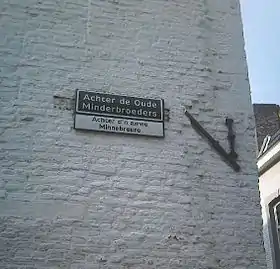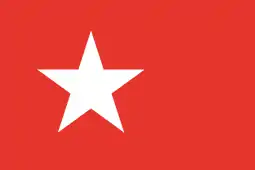Maastrichtian dialect
Maastrichtian (Limburgish: Mestreechs) or Maastrichtian Limburgish (Limburgish: Mestreechs-Limburgs [məˈstʀeːxsˈlimbœʀxs]) is the dialect and variant of Limburgish spoken in the Dutch city of Maastricht alongside the Dutch language (with which it is not mutually intelligible). In terms of speakers, it is the most widespread variant of Limburgish, and it is a tonal one. Like many of the Limburgish dialects spoken in neighbouring Belgian Limburg,[2] Maastrichtian retained much Gallo-Romance (or more accurately, French and Walloon) influences in its vocabulary.[3]
| Maastrichtian | |
|---|---|
| Mestreechs (sometimes Mestreechs-Limburgs or colloquially Dialek, Plat) | |
| Pronunciation | [məˈstʀeːxs] |
| Native to | the Netherlands |
| Region | City of Maastricht |
Native speakers | 60,000 |
Indo-European
| |
| Official status | |
Official language in | Limburg, Netherlands: Recognised as regional language as a variant of Limburgish. |
| Regulated by | Veldeke-Krink Mestreech |
| Language codes | |
| ISO 639-3 | – |
| Glottolog | None |
The French influence can additionally be attributed to the historical importance of French with the cultural elite and educational systems as well as the historical immigration of Walloon labourers to the city. Despite being a specific variant of Limburgish, Maastrichtian remains mutually intelligible with other Limburgish variants, especially those of surrounding municipalities.
Whilst Maastrichtian is still widely spoken, regardless of social level, research has shown that it is suffering from a degree of dialect loss amongst younger generations. That is the case in dwindling of speakers but also in development of the dialect (dialect levelling) towards Standard Dutch (like the loss of local words and grammar).[1]
Geographic distribution, social status and sociolects

Maatrichtian being a city dialect, the terminology "Maastrichtian" (Mestreechs) is practically limited to the municipal borders, with the exception of some places within the Maastrichtian municipality where the spoken dialects are in fact not Maastrichtian. These exceptions are previously separate villages and/or municipalities that have merged with the municipality of Maastricht namely Amby, Borgharen, Heer and Itteren.
The social status of Maastrichtian speakers is determined by the type of sociolect spoken by a certain person, with a division between Short Maastrichtian or Standard Maastrichtian [4] (Kort Mestreechs, Standaardmestreechs) and Long/Stretched Maastrichtian (Laank Mestreechs). Short Maastrichtian is generally considered to be spoken by the upper and middle classes, whilst Long Maastrichtian is considered to be spoken by the working class.
A particular feature of Maastrichtian is that it gives its speakers a certain prestige.[5] Research of the dialect showed that people talking the "purest" form of Maastrichtian, i.e. the Short Maastrichtian (Kort Mestreechs) sociolect, were perceived by others to be the well-educated ones.
Written Maastrichtian
The oldest known and preserved text in Maastrichtian dates from the 18th century. This text named Sermoen euver de Weurd Inter omnes Linguas nulla Mosa Trajestensi prastantior gehauwe in Mastreeg was presumably written for one of the carnival celebrations and incites people to learn Maastrichtian. As from the 19th century there are more written texts in Maastrichtian, again mostly oriented towards these carnival celebrations. Nowadays however, many other sources display written Maastrichtian, including song texts not written for carnival as well as books, poems, street signs etc.
Standardisation and official spelling
In 1999, the municipal government recognised a standardised spelling of Maastrichtian made by Pol Brounts and Phil Dumoulin as the official spelling of the dialect.[4]
Dictionaries
- Aarts, F. (2005). Dictionairke vaan 't Mestreechs. (2nd ed.). Maastricht, the Netherlands: Stichting Onderweg.
- Brounts P., Chambille G., Kurris J., Minis T., Paulissen H. & Simais M. (2004). De Nuie Mestreechsen Dictionair. Maastricht, the Netherlands: Veldeke-Krink Mestreech.
Other literature on Maastrichtian
- Aarts, F. (2009). 't Verhaol vaan eus Taol. Maastricht, the Netherlands: Stichting Onderweg.
Local anthem
In 2002, the municipal government officially adopted a local anthem (Mestreechs Volksleed) composed by lyrics in Maastrichtian. The theme had originally been written by Alfons Olterdissen (1865–1923) as finishing stanza of the Maastrichtian opera "Trijn de Begijn" of 1910.[6] There are claims that the anthem actually originates from "Pe-al nostru steag e scris Unire" by the Romanian composer Ciprian Porumbescu.[7]
Wikimedia
- Wikipedia: Maastrichtian is included in the Limburgish Wikipedia. Since there are only standardised 'variants' of Limburgish but no widely accepted/recognised standardised Limburgish itself, each article is tagged as being written in a certain variant of the language. All articles in Maastrichtian can be found here.
- Wiktionary: For an overview of some Maastrichtian dialect specific words, their English translations and their origins proceed to this Wiktionary category.
Phonology
The phonology of the Maastrichtian dialect, especially with regards to vowels is quite extensive due to the dialect's tonal nature.
Monophthongs

| Front | Central | Back | |||||
|---|---|---|---|---|---|---|---|
| unrounded | rounded | ||||||
| short | long | short | long | short | long | ||
| Close | i | iː | y | yː | u | uː | |
| Close-mid | ɪ | eː | øː | ø | o | oː | |
| Open-mid | ɛ | ɛː | œ | œː | ə | ɔ | |
| Open | æ | aː | ɑ | ɔː | |||
- The front vowels /ɪ, eː, æ, aː/ are somewhat retracted [ɪ̞, e̠ː, æ̠, a̠ː], but not retracted enough to be labelled as central vowels. On the other hand, /ø/ is so retracted that it is best labelled as central [ɵ].[8]
- Among the central vowels, /ø/ is rounded, whereas /ə/ is unrounded.
- /ə/ occurs only in unstressed syllables.[9]
- Among the back vowels, /u, uː, o, oː, ɔ, ɔː/ are rounded, whereas /ɑ/ is unrounded.
- The qualitative differences between the short /ɪ, ø, o/ and long /eː, øː, oː/ close-mid vowels are not very big; the short vowels are slightly higher and somewhat more central. In the case of the /ø/–/øː/ pair, the difference is the smallest.[8]
- Among the open-mid vowels, only /ɛː, œː, ɔ/ are open-mid [ɛː, œː, ɔ], whereas /ɛ, œ, ə/ are actually mid [ɛ̝, œ̝, ə].[8]
- The open vowels /æ, ɑ, ɔː/ are somewhat raised (i.e. near-open) [æ, ɑ̝, ɒ̝ː]. /æ/ is similar in quality to /ɛː/; the main difference between them is backness (/æ/ is somewhat more retracted), rather than height.[8]
- The short counterpart of /aː/ is /ɑ/, not /æ/ (which does not have a long counterpart).
Diphthongs

Diphthongs in Maastrichtian are /ɛi, œy, ɔu/ having closer starting points than the equivalent three in Standard Dutch. The start point of /ɔu/ is rounded unlike standard Dutch /ʌu/.[8]
Consonants
| Labial | Alveolar | Postalveolar | Dorsal | Glottal | ||
|---|---|---|---|---|---|---|
| Nasal | m | n | ɲ | ŋ | ||
| Plosive | voiceless | p | t | c | k | (ʔ) |
| voiced | b | d | ɡ | |||
| Fricative | voiceless | f | s | ʃ | x | |
| voiced | v | z | ʒ | ɣ | ɦ | |
| trill | ʀ | |||||
| Approximant | β | l | j | |||
- /m, p, b, β/ are bilabial, whereas /f, v/ are labiodental.[1]
- Voiceless plosives are unaspirated, whereas the voiced plosives are fully voiced.[10]
- Word-initial /v/ and especially /ɣ/ can be only partially voiced [v̥, ɣ̊] but without merging with, respectively, /f/ and /x/.[10]
- /ɲ, c, ʃ, ʒ/ are laminal postalveolar. Phonemically, they can be analysed as /nj, tj, sj, zj/.[10]
- /ŋ, k, ɡ, x, ɣ/ are velar, whereas /j/ is palatal.[1]
- Word-initial /x/ is restricted to loanwords.[10]
- /ʀ/ is a voiced fricative trill, either uvular [ʀ̝] or pre-uvular [ʀ̝˖]. The fricative component is particularly audible in coda, where a partial devoicing to [ʀ̝̊ ~ ʀ̝̊˖] also occurs.[10]
- A non-phonemic glottal stop [ʔ] can be heard when separating a preceding unstressed vowel (particularly a schwa [ə]) from other following vowel sounds.
| Voiceless | Voiced | ||||||
|---|---|---|---|---|---|---|---|
| Phoneme | IPA | Orthography | Meaning | Phoneme | IPA | Orthography | Meaning |
| /m/ | /miβ/ | miew | 'gull' | ||||
| /n/ | /nœy/ | nui | 'new' | ||||
| /ɲ/ | /koˈɲɑk/ | cógnac | 'brandy' | ||||
| /ŋ/ | /ɪŋ/ | ing | 'scary' | ||||
| /p/ | /pʀiːs/ | pries | 'price' | /b/ | /bʀoːʀ/ | broor | 'brother' |
| /t/ | /tiːt/ | tied | 'time' | /d/ | /daːk/ | daak | 'roof' |
| /c/ | /ˈbɑcɑkəʀ/ | batjakker | 'rascal' | ||||
| /k/ | /klɔːʀ/ | klaor | 'ready' | /ɡ/ | /ˈlɛɡə/ | lègke | 'lay' |
| /f/ | /fiːn/ | fien | 'fine' | /v/ | /vaːn/ | vaan | 'of' |
| /s/ | /ɑs/ | as | 'ash' | /z/ | /ziː/ | zie | 'sea' |
| /ʃ/ | /ʃeːp/ | sjeep | 'schip' | /ʒ/ | /ʒyβəˈleːʀ/ | zjuweleer | 'jeweller' |
| /x/ | /ɔux/ | ouch | 'also' | /ɣ/ | /ɣoːt/ | good | 'good' |
| /ɦ/ | /ɦɛi/ | hei | 'here' | ||||
| /ʀ/ | /ʀoːnt/ | roond | 'round' | ||||
| /β/ | /βiːn/ | wien | 'whine' | ||||
| /l/ | /lɪŋks/ | links | 'left' | ||||
| /j/ | /jɔː/ | jao | 'yes' | ||||
Orthography
| Consonants | ||||||||||||||||||||
| b | ch | d | f | g | gk | h | j | k | l | m | n | ng | p | r | s | sj | t | v | w | z |
| Vowels (both monophthongs and diphthongs) | ||||||||||||||||||||||||||||||
| a | aa | aaj | aj | ao | aoj | äö | äöj | aj | au | aw | e | è | ee | ei | ej | eu | ew | i | ie | iew | o | ó | ö | oe | oo | ooj | ou | u | ui | uu |
Vocabulary
Maastrichtian contains many specific words ample or not used in other Limburgish dialects some being creolisations/"limburgisations" of Dutch, French and German words while others cannot be directly subscribed to one of these languages.
(Historical) Vocabulary influences from other languages
Maastrichtian vocabulary, as the language family it belongs to suggests, is based on the Germanic languages (apart from the Limburgish language family this also includes varying degrees of influence from both archaic and modern Dutch and German). However, what sets Maastrichtian apart from other variants of Limburgish is its relatively strong influences from French. This is not only because of geographic closeness of a Francophone region (namely Wallonia) to Maastricht but also because of French being the predominant spoken language of the Maastrichtian cultural elite and the higher secondary educational system of the region in the past. Some examples:
Francophone influence
| English | Dutch | French | Maastrichtian [3][4] |
|---|---|---|---|
| to advance | vooruitkomen | avancer | avvencere |
| bracelet | armband | bracelet | brazzelèt |
| errand | boodschap | commission | kemissie |
| jealous | jaloers | jaloux | zjelous |
| to remember | (zich) herinneren | se rappeler | (ziech) rappelere |
| washbasin | wastafel | lavabo | lavvabo |
Germanophone influence
| English | Dutch | German | Maastrichtian [3][4] |
|---|---|---|---|
| bag | zak, tas | Tüte | tuut |
| ham | ham | Schinken | sjink |
| liquorice candy | drop | Lakritze | krissie |
| plate | bord | Teller | teleur |
| ready, done | klaar | fertig | veerdeg |
| swing (for children) | schommel | Schaukel | sjógkel |
Other examples of Maastrichtian vocabulary
Some examples of specific Maastrichtian vocabulary:
| English | Dutch | French | German | Maastrichtian [3] | Notes |
|---|---|---|---|---|---|
| approximately, roughly | ongeveer | appoximativement, environ | ungefähr | naoventrint | |
| bag | tas | sac | Tasche | kalbas | |
| completely | helemaal, gans | tout à fait | ganz | gans | (historically) Common in Germanic languages |
| frame (of doors and windows) | lijst | cadre (or chambranle) | Rahmen | sjabrang | |
| grandmother / grandfather | grootmoeder / grootvader | grand-mère / grand-père | Großmutter / Großvater | bomma(ma) / bompa(pa) | |
| sieve | vergiet | passoire | Sieb | zeiboar (sometimes written zeijboar) | |
| where? | waar? | où? | wo? | boe? |
Expressions and Titles
Some examples of Maastrichtian expressions:
| Maastrichtian Expression | Meaning (Approx.) | Notes [3] |
|---|---|---|
| Neet breid meh laank | Literally "Not broad but long". Commonly used to indicate the characteristic of the Maastrichtian dialect to "stretch" vowels (in speech and writing). The word laank (long) is the example in this case whereas it would be written as either lank or lang in other variants of Limburgish and lang in Dutch. | |
| Noondezju [3] | A minor swear word and /or an expression of surprise | From Eastern Walloon "nondidju", meaning "(in) name of God" |
| Preuvenemint | Name of an annual culinary festival held in Maastricht | A contraction of the Maastrichtian words preuve (to taste) and evenemint (event) |
References
- Gussenhoven & Aarts (1999:155)
- Rob Belemans & Benny Keulen, Taal in stad en land: Belgisch-Limburgs, 2004
- Brounts P.; Chambille G.; Kurris J.; Minis T.; Paulissen H.; Simais M. (2004). "Veldeke Krink Mestreech: Nuie Mestreechsen Dictionair". Veldeke-Krink Mestreech. Retrieved 2008-12-25.
- Aarts, F. (2009). "t Verhaol vaan eus Taol". Stichting Onderweg. Missing or empty
|url=(help) - Muenstermann, H. (1989). Dialect loss in Maastricht. Walter de Gruyter. ISBN 9789067652704. Retrieved 2009-07-12.
- Municipality of Maastricht (2008). "Municipality of Maastricht: Maastrichts Volkslied". N.A. Maastricht. Retrieved 2009-08-05.
- Roca, George (28 January 2016). "Pe-al vostru steag e scris Unire!?". Gândacul de Colorado (in Romanian).
- Gussenhoven & Aarts (1999:159)
- Gussenhoven & Aarts (1999:157)
- Gussenhoven & Aarts (1999:156)
Bibliography
- Gussenhoven, Carlos; Aarts, Flor (1999), "The dialect of Maastricht" (PDF), Journal of the International Phonetic Association, University of Nijmegen, Centre for Language Studies, 29 (2): 155–166, doi:10.1017/S0025100300006526
Further reading
- van der Wijngaard, Ton (1999), "Maastricht" (PDF), in Kruijsen, Joep; van der Sijs, Nicoline (eds.), Honderd Jaar Stadstaal, Uitgeverij Contact, pp. 233–249
